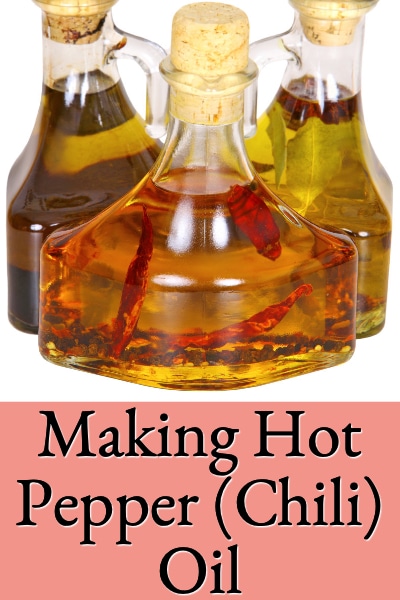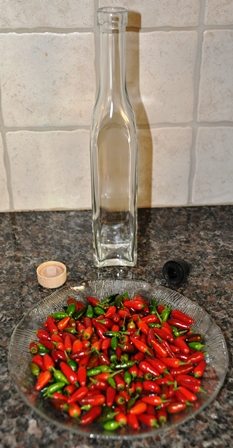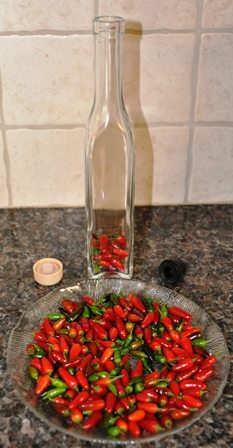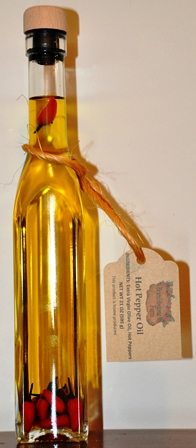
Why Make Hot Pepper (or Chili) Oil?
In Italy, we noticed that many restaurants had hot pepper (or chili) oil on the tables instead of pepper flakes, and we found ourselves liking it better. It spreads the flavor out a bit, and you don’t get the sudden shock of biting into a red pepper flake.
Leave it to the Italians to find another great way to use extra virgin olive oil in their meals. Since we enjoyed it so much, I decided to make some, and it couldn’t be simpler.
How To Make Chili Oil
Simply take an appropriate bottle (I save the bottles that we get balsamic vinegar in because they’re nicely sized and have a nice pouring spout/cap combination) and sterilize in boiling water or the dishwasher.
Also, buy or grow some small hot peppers. I grew one plant of Thai hot pepper this year, and what you see in the picture is about half of the hot peppers we got from that one plant – you don’t need many plants. If you’ve got excess hot peppers left, you can also make hot pepper jelly.

Chilis & Bottle for Hot Pepper (Chili) Oil
Wash the hot peppers, let the peppers dry out thoroughly (as in sun-dried or dehydrated – they should look crinkled and dry before you use them), and add 20 or so to the bottle.
If you make a small slit in the peppers before adding them to the bottle, you can speed up the infusion process – but in these photos, I didn’t slit the peppers.

Hot Peppers In Bottle Prior To Olive Oil
Add extra virgin olive oil (you probably don’t need a great extra virgin olive oil for this, because it’s going to get hot and you may not be able to tell that it’s a great olive oil) and wait.
When you first add the oil, the peppers will float to the top, but as they fill with oil they’ll gradually sink to the bottom of the bottle. After several weeks, the oil will begin tasting spicy, and eventually will be quite spicy.
Use to shake on pizza, pasta, and anything that you’d like to kick up a notch (as Emeril would put it). These might also make nice homemade hostess or Christmas gifts.

Finished Hot Pepper (Chili) Oil
Shelley says
How long does it take die the oil to become spicy? And how long does the oil last? Trying to gauge when to make it for gifts thx
Lesa says
Hi Shelley, How long it takes for it to become spicy will depend on whether you slit some of the peppers. If you slit them it will infuse faster, but you’ll end up with chili seeds in the oil and I don’t think that’s as pretty. I’d give at least 6 weeks. And mine lasts until I use it up and make more.
Shelley says
Thx
Christine Goeppinger says
How long do you let it infuse and does it make a difference weather left covered on the countertop or in the fridge? Ours has been brewing about a month in the fridge and it’d not hardly spicy or hot
Lesa says
Hi Christine,
After infusing for several weeks, it should be getting spicy. However, I never put ours in the refrigerator, I always kept it in the pantry at room temperature.
Susie says
Hi, I’ve been searching for chilli oil recipes and they mention a very short shelf life and even comments of botulism risk. What are you thoughts on this?